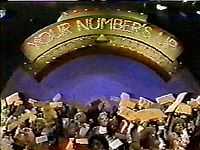Your Number's Up
| Your Number's Up | |
|---|---|
 | |
| Genre | Game show |
| Created by | Sande Stewart |
| Presented by |
Nipsey Russell with Lee Menning |
| Narrated by |
Gene Wood John Harlan Johnny Haymer (substitute) Johnny Gilbert (substitute) |
| Theme music composer | Bob Cobert |
| Country of origin |
|
| No. of episodes | 65 |
| Production | |
| Producer(s) | Sande Stewart |
| Running time | approx. 26 minutes |
| Broadcast | |
| Original channel | NBC |
| Original run | September 23, 1985 – December 20, 1985 |
Your Number's Up is a game show that aired on NBC from September 23 to December 20, 1985. The show was hosted by Nipsey Russell with Lee Menning as co-host. Announcing duties were handled by Gene Wood for the first month and John Harlan for the rest of the run, with Johnny Haymer and Johnny Gilbert as substitutes.
This show was the first series produced by Sande Stewart, son of game show producer Bob Stewart. Your Number's Up was put up against the elder Stewart's The $25,000 Pyramid on CBS at 10:00 AM Eastern. Most of the staff from Bob Stewart Productions also worked in the production of this series.
Rules
Three on-stage players, two new challengers and one returning champion, were each given one point at the outset of the game, indicated by diamonds on the front of their podiums. Also in front of the players' podiums was an electronic wheel with digits 0-9, blank spaces and a car symbol. The digits and symbols were spaced so that when the wheel stopped, two players would have a digit or car symbol in front of them while the third had a blank. Players spun the wheel by pulling a lever. After each spin, the player whose space was blank was shown the first halves of two riddle-type phrases, each with an acronym to be filled in. An example of these would be as follows:
"When T.O. speaks..."
"As predicted, the I.O.M...."
After the player selected one of the two phrases, the host read its second half to the other two players (example: after selecting the first phrase above, the host read "...all of the House listens." Answer: Tip O'Neill). The first player to buzz-in and fill in the acronym correctly scored one point and spun the wheel for the next turn; incorrect guesses deducted one point. If neither opponent guessed correctly, the player who selected the riddle won $50 and spun again, but did not score any points. The first player to score six points won the game and $500.
If the car symbol appeared under a player's pointer, that player attempted to guess which digit was hidden under a question mark on a car's license plate. The first three weeks of the series used a new plate for each attempt. Later, a single plate was used, with previous incorrect digits automatically eliminated from each subsequent attempt. Guessing correctly won the player the car regardless of the game's outcome.
Audience game
When a riddle was answered correctly, that player's digit was added to a board hanging above the stage. At any point during the game, if the last four digits of any studio audience member's phone number appeared on the board (in any order, not necessarily in sequence), that audience member came up on stage to predict which player would win the game. A maximum of three audience members could participate in this manner during any one game, with each choosing a different player. If an audience member correctly chose the winner, that member won a trip.
If a digit was duplicated in an audience member's phone number, they had to wait until all instances of that digit were placed on the board. For example, an audience member with "1234" needed one of each digit to come on stage, while one with "5555" needed four 5's to be eligible.
Bonus round
The winner drew a postcard sent in by a home viewer, who immediately won $1,000. Prior to the first episode, postcards were obtained via an ad in TV Guide; during the show's run, viewers with telephone numbers whose last four digits appeared on the main game board were eligible to send in cards. The player then had 60 seconds to reveal the last four digits of the chosen viewer's phone number. He/she selected a digit 0-9 from a board which resembled a touch-tone phone keypad, with an acronym displayed below each digit, and a clue was read. (Example: F.S. is known as the Chairman of the Board - answer: Frank Sinatra.) If the player answered correctly, any instances of the chosen digit in the home viewer's phone number were revealed and the digit was removed from the board. If the player answered incorrectly or passed, a new acronym was put below that digit.
The player won $100 for each correct answer, or $5,000 for revealing the entire number. If the player won the bonus game on any day from Monday through Thursday, the home viewer received an additional $1,000; a Friday win awarded $5,000 more. After the series was canceled, 15 home viewers won $1,000 each in a random drawing from the unused postcards.[1]